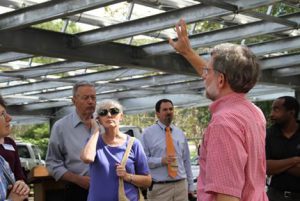I know you’ve seen the rear window decals that announce in stick figures just who could be riding in that SUV – mom, dad, kids of various sizes, and sometimes pets. A clever Florida variation uses big and little flip-flops and paw prints to paint the same picture.

Photo: Will Sheftall
Flip-flops on the beach = footprints in the sand = carbon footprints on the Earth – at least, that’s how my mind processes this voluntary family accounting, posted for all to see. I wonder if I’m the only driver out there who studies a family’s flip-flop line-up at the stop light, and ponders our human family’s footprint on Earth’s climate and other natural resources.
My mind can imagine the line-up of flop-flops as belonging just to me. The two big pairs (representing mom and dad on the rear glass) evoke the four big lifestyle footprints I leave on this Earth. My lifestyle footprints are made by what I eat and how it was produced, the way I commute and travel, the buildings in which I live and work, and by what I wear and how it was made. Lifestyle footprints left on Earth’s resources are the water and energy I consume directly and indirectly, plus greenhouse gas emissions and wastes with my name on them.
Wouldn’t it be great if we could shrink the size and impact of one of those pairs of big flip-flops with an integrated solution, a twofer – reducing two of our lifestyle footprints by linking them together? There is an opportunity to do just that by combining solar PV (solar photovoltaics, better known as solar panels) with EVs (electric vehicles), to achieve an integrated reduction in the energy and carbon footprints of the two together. This opportunity is available to families for home application, and to agencies/ businesses for work application. It’s particularly exciting to envision the prospect of reducing commercial/ institutional CO2 footprints by combining net-metered solar PV on zero-net office buildings and warehouses, with EV’s for business errands and local deliveries.
Here’s some insight into how this might work. The office building in which I work is an award-winning, energy-exporting “Sustainable Demonstration Center” for Leon County government. It’s the UF IFAS Extension Center in Leon County, on Paul Russell Road. Constructed in 1961 and retrofitted with solar PV and geothermal HVAC in 2012, it was certified in 2014 by the New Buildings Institute as the third commercial/ institutional “zero-net energy” building in Florida. It has a grid-tied, net-metered system.
In the 4¾ years since our facility’s solar PV and geothermal energy systems went on-line in March 2012, thermostats in this County government building have been managed to obtain even greater energy conservation than was envisioned when planning the retrofit. As a result, our facility has exported a continually growing net surplus of energy to the City of Tallahassee Utilities grid – over and above covering its own energy needs. The amount of surplus energy donated since just August 2014 stands at 24,400 kWh.

Photo: Kendra Zamojski
To put this amount of energy into context, let’s consider what mechanical work 24,400 kWh of electrical energy can do. Here’s where the other half of the twofer opportunity comes in. On an accessible battery charge of 10.5 kWh, an extended range electric vehicle (EV) such as the Chevrolet Volt goes a summer/ winter average of 40 miles on stored battery power alone. 24,400 kWh would provide the equivalent of 2324 EV charges at 10.5 kWh per charge. That’s enough stored battery power for 92,960 electric miles!
Forget about this surplus from the past for a moment. Let’s compute the repeating annual surplus of clean solar energy produced by our PV array, and apply that to the opportunity for integrating building and travel footprints at Leon Extension. If we compute that our solar PV system has produced – over the past 2.3 years – an annual energy surplus equivalent to 997 EV charges per year, and if we project that Extension Agents could utilize County vehicles to travel 40 miles every work day for 245 work days/year, then we find there would be enough surplus energy produced every year to fully charge a fleet of four EVs at 10.5 kWh per charge/day, for use on the job every single work day.
This is exciting stuff! With more auto manufacturers offering new EV models with longer ranges and lower prices – and with extension through 2019 of the 30% federal tax credit for residential solar and the 30% federal Business Energy Investment Tax Credit (ITC) for business solar, the future of PV + EV looks bright. Perhaps this rosy outlook will encourage government offices and businesses around town to shrink those two big flip-flops down in size with a twofer, and ‘Leave a Lower Carbon Footprint Trace’ on the Earth.
 0
0
